Does India have a “Healthy” Economy?
 Image credits: Google images
Image credits: Google images
In an economy, Healthcare plays an important role. It is a nation’s responsibility to take good care of the citizens. Without a good healthcare plan, a country’s economy can be dismayed. Here is where the budget and GDP plays an important role. A good health budget and a decent percentage of GDP spent in health care can add on to the total economy. But does our country have a good health economy? Well, India has an aim to achieve Universal Health Coverage (UHC) as part of Sustainable Development Goals. But its total health expenditure never went beyond 5% of GDP. We usually hear the word GDP while referring to a country’s economy. What exactly is GDP?
Indian Economy
India has a mixed developing economy. What makes India standout is that India is one of the fastest growing economies in the world. Anybody who refers to a country’s economy may most likely mean its GDP growth. So, as we all know ‘Gross domestic product (GDP) is a monetary measure of the market value of all final goods and services produced over a period of time.’ GDP doesn’t include net income from abroad. In India, trade, hotels, transport, and communication, financing, insurance, real estate and business services and community, social and personal services account for more than 60 percent of GDP. India’s GDP has been consistently growing ever since the colonial rule. According to the latest data, India’s GDP now stands at 7.2% and is expected to grow at a rate of 7.3% this year. Below given is a graph that depicts the change in the GDP over the last 10 years.
Figure 1 : Overall change in GDP
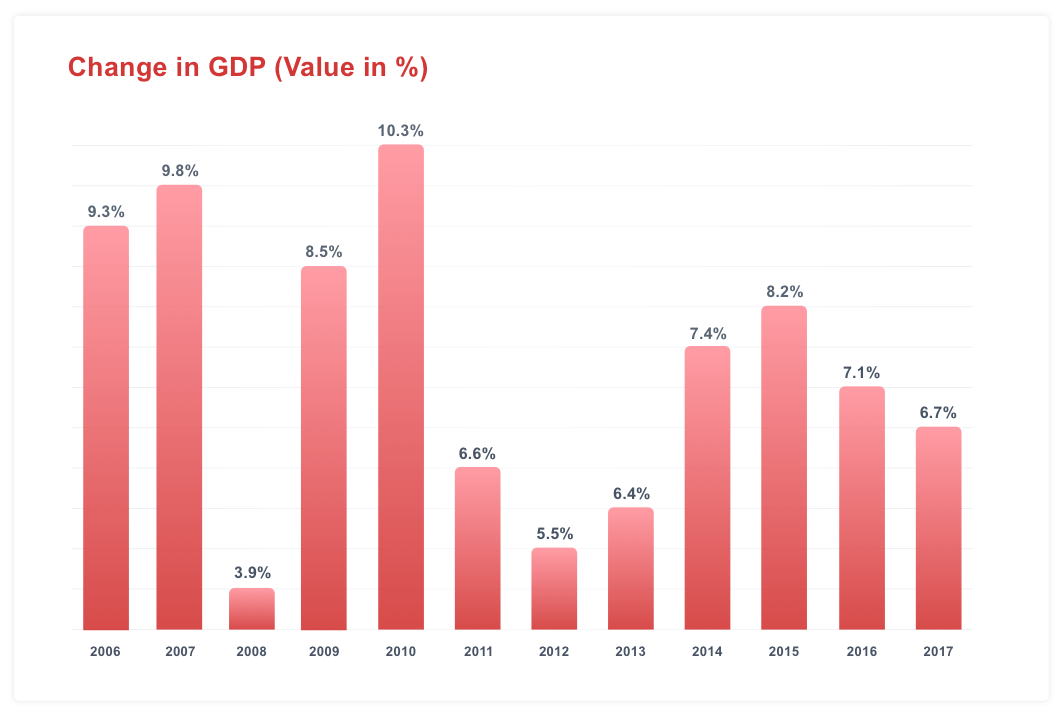
Health Economy: Something that needs to be taken care of.
As already mentioned, health is one of the important sectors that have to be taken care of in the economy. India is the universal hub of all the healthcare systems in the world. Availability of intelligent workforce and high-quality clinical outcomes at an affordable cost has helped India achieve this title. But does our country gives proper care to the healthcare sector while it comes to the budget and allocations? The answer would be a ‘no’ nod. The public funding of health sector remains at 1.2 percent of GDP, with Central government spending constituting a third of overall government funds.
Figure 2: Total Health expenditure in terms of GDP (Including private and public spending)
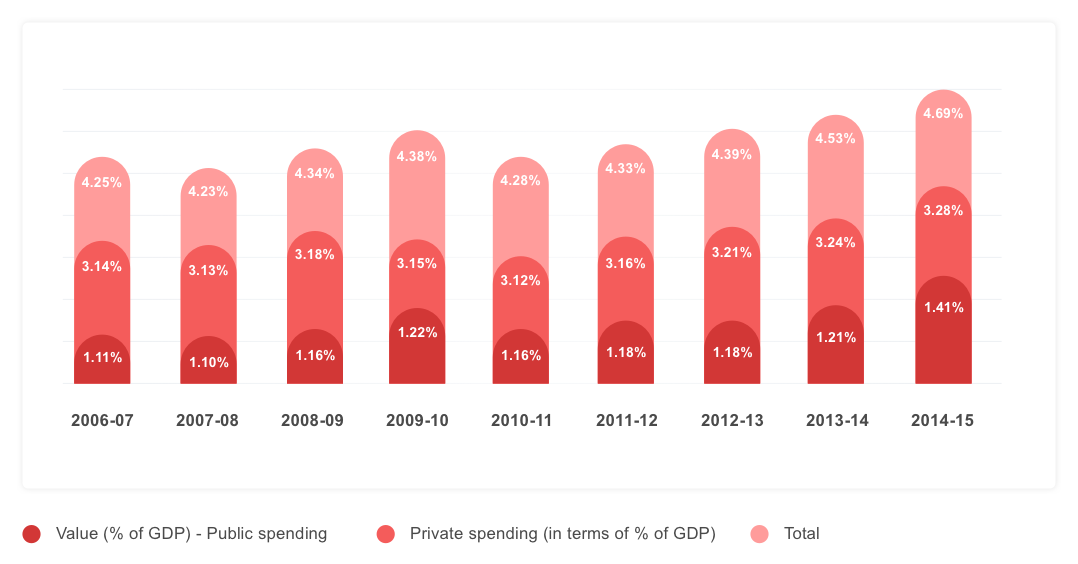
A trend that prevails in our country is that though there are health policies and initiatives when it comes to budget healthcare sector doesn’t get the needed allocations. If we go through the history of the health budget, we can find out that how much percentage has been allocating to the healthcare sector. Be it the budget or GDP, health care never got what it is meant to get. For instance, if we take into consideration, the data of public spending in healthcare, we can see that it never went beyond 1.5% of GDP. India has among the lowest public spending on health as a share of GDP compared to other countries, while the global average is approximately 5.99%. But what is ironical here is that India’s disease burden is high, but the spending is low. In India, private spending overshadows public spending when it comes to health. Let us take a look at the public and private spending in the healthcare of the country.
Public and Private Spending on Healthcare.
Government spending on health has been deteriorating over the past years. This has paved the way for the private healthcare sectors to flourish. The extent of private sector involvement in an economy is a still existing debate. Even in such context, what may be the reason for the private sector being a preferred choice in India? The reason is that
- The government spending on healthcare is low, which forces people to spent high amounts from their pockets to the private healthcare.
Health experts are of opinion that increased public spending with a strictly regulated private sector is acceptable. But the situation prevails now is, the government spending stagnates and the private sector booms. If we check the investment data on health care spending, we can clearly find a difference between the private and public spending.
Figure 3: Universal health care performance of different countries (2016)
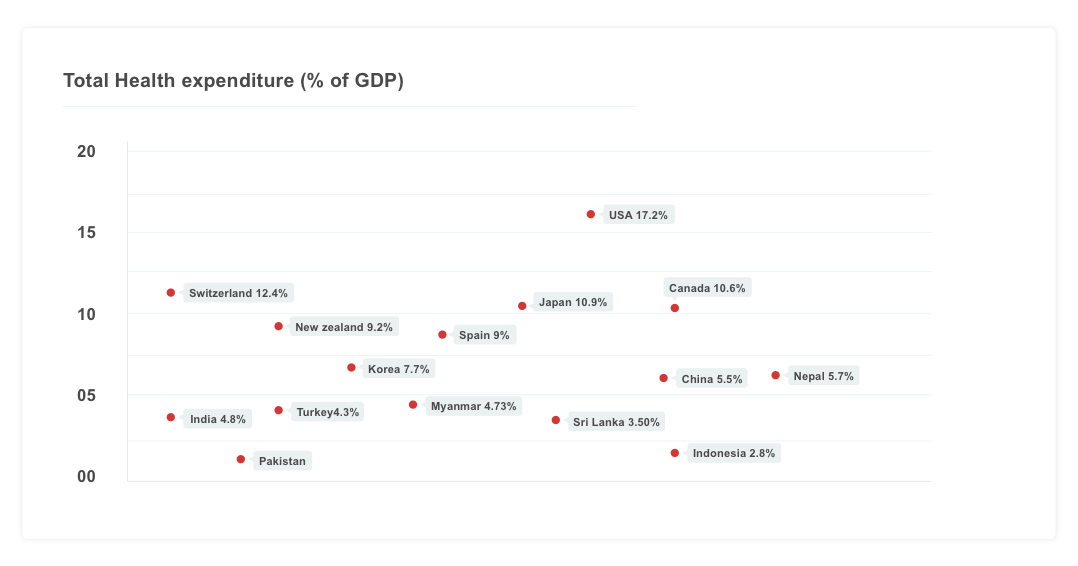
- There have been several opinions on increasing the GDP spending on health to 2.5%.
- At present, the government spends only less than 1.5% of GDP on health.
- Private health spending in India is double than the public spending. Private health expenditure in India is 3.28% as of 2014.
It is clear that this trend has opened room for the private sector to flourish. In total, India spends only less than 5% of its GDP on healthcare, one of the lowest in the world. The world average total spending on healthcare is approximately 10%.Though there is a rise in the government spending on health in absolute terms and on a per-capita basis, there is no significant increase in the percentage of money allocated to healthcare. According to the findings of the health ministry,
- Centre’s share in health spending has been declining steadily even as the share of states in total public health expenditure has been increasing.
- Government data depicts that public spending on health has not risen much over the last six years. For instance, the public expenditure on health as a percentage of GDP was 1.22 in 2009 and has shown a marginal increase of 1.41 in 2014.
- The total % of GDP that the government spends on health is ridiculously low when compared to the country’s needs, especially when compared to the patient flow.
- Statistics show that 62.42% of health spending in India was borne by citizens. If a country’s public health system is good, the percentage of the amount spent by citizens on their own should come down.
Also,Healthcare has seen a significant increase in FDI inflow over the last 4 years and most of the leading private hospital chains have shown steady revenue growth.
Rural and Urban health sectors
Around 70% of Indian population live in Rural areas. When it comes to healthcare, the rural population never enjoys enough options for treatment. Over the last decade, the government is putting arduous efforts in enhancing the current healthcare systems by establishing primary health centers and policies. But the situation remains the same when it comes to availability of qualitative treatment in the remote areas. The rural healthcare infrastructure is three-tiered and includes a sub-center, primary health center (PHC) and CHC(Community Health Centers). {pie chart)
According to the reports,
- 75% of the health infrastructure in India – including doctors and specialists and other health resources – is concentrated in urban areas where only 27% of India’s population lives.
- Most people living in rural areas or small cities and towns across India don’t have access to critical medical facilities including hospitals, medicines, and doctors.
- Though the urban sector of India has good treatment facilities, the doctor-patient ratio is low compared to its disease burden and patient inflow.
- WHO prescribes a doctor ratio of 1 for 1000 people. But India have less than 1 doctor for 1000 population even in urban areas.
- The ratio of rural population to doctors is six times lower than in urban areas.
- The ratio of hospital beds in rural areas is 15 times lower than in urban areas.
- 66 percent of the rural population in India lacks access to preventive medicines
- 31 percent of the rural population in India has to travel over 30 km to get needed medical treatment
- 3,660 PHCs in rural India lack either an operation theater or a lab, or both.
- 50 percent of the posts for obstetricians, pediatricians, and gynecologists in PHCs or CHCs are vacant.
- There is a 70.2 percent shortfall of medical specialists in CHCs.
- 39 percent of PHCs are currently without a lab technician
- Infectious diseases dominate the morbidity pattern in rural areas: 40% in rural areas compared to 23.5% in urban areas.
Figure 4 : Health Indicators of Rural and urban sectors in India
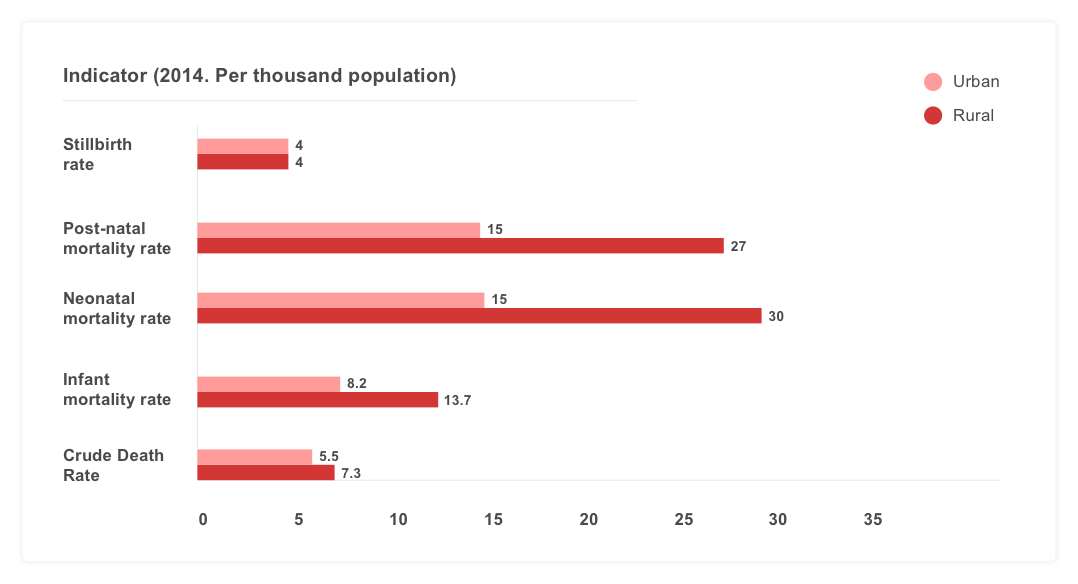
Although the National Rural Health Mission (NRHM) spends Rs 101,166 crore on rural healthcare in India, various key issues including healthcare infrastructure and access to medical services still exist as a fissure in the healthcare. Most of the funding of the healthcare comes from the budget and other health policies. But the households remains the dominant contributors to health finance in India. Rest of the funds are generated by the state and central governments. But as mentioned earlier public funding remains too low to meet the expenses in the healthcare.
Health Insurances
According to Insurance Regulatory and Development Authority (IRDA), India’s per capita healthcare expenditure is one of the lowest in the world. Considering the poor state of healthcare infrastructure, health insurance is a product that every Indian must acquire.
- As per IRDA report 2013, only 207 million people had health insurance.
- Only 18% (government funded 12%) of the urban population and 14% (government funded 13%) of the rural population was covered under any form of health insurance.
- Lower coverage of health insurance results in higher out of pocket expenses at the time of medical emergency.
- Compared to other countries, India’s out-of-pocket expenditure is high.
- In China, out-of-pocket expenditure is as a percentage of total health expenditure is 32%. It is 11% in US and averages around 18.2% for the world.
- 4.5% or app. 58M people are being pushed into poverty bcoz of oope health spending
- 31.9% of total population uses more than 10% of their total expenditure on health care.
- Out of total government expenditure, only 5% goes for health sector.
Figure 5: Out of pocket Health expenditure as proportion of Total Health Expenditure
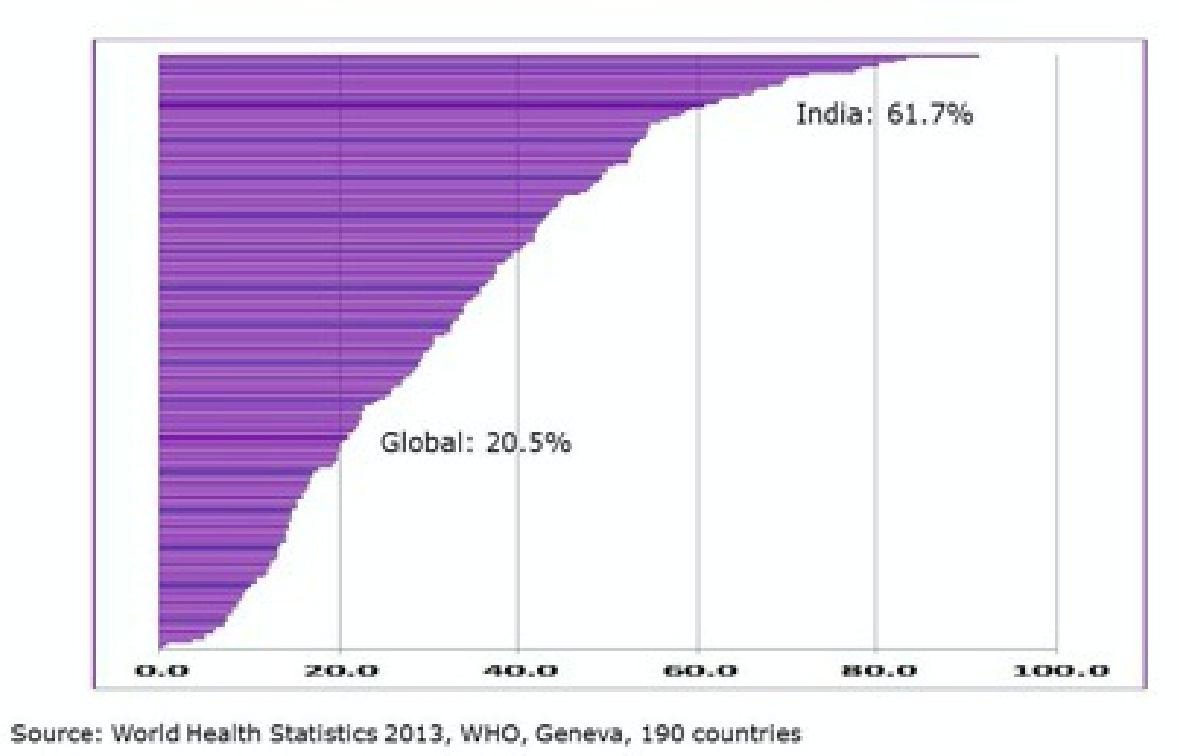
Despite the above-mentioned facts, the current statistics show that health insurance segment is rising specifically after liberalization of the insurance sector.
- Health insurance is one of the rapidly growing areas in the insurance sector of India.
- Its growth premium was only 675 Crore in 2001-2002.
- The number of lives covered under Health Insurance policies during 2015-16 was 36 crore which is approximately 30 percent of India’s total population.
- India has both government insurance schemes and private health insurance schemes.
- Indian government has now announced a health scheme called National Health Protection Scheme (NHPS) or Ayushman Bharat scheme.
- Ayushman Bharat is National Health Protection Scheme, which will cover over 10 crore poor and vulnerable families (approximately 50 crore beneficiaries) providing coverage up to 5 lakh rupees per family per year for secondary and tertiary care hospitalization. Ayushman Bharat – National Health Protection Mission will include the existing centrally sponsored schemes – Rashtriya Swasthya Bima Yojana (RSBY) and the Senior Citizen Health Insurance Scheme (CHIS).
- Rashtriya Swasthya Bima Yojna was a government-run health insurance programme for the Indian poor. The scheme aims to provide health insurance coverage to the unrecognized sector workers belonging to the BPL category and their family members shall be beneficiaries under this scheme.
Once after the scheme will be implemented, the coverage of insurance will be increased to three times. Also, we can expect a rise in affordable rural-focused hospitals. The implementation of new scheme can reduce the out of pocket expenditure to a certain extent. The payment charges for the treatment will be done in packages through this scheme. The new scheme can add on to the GDP as well.
- The implementation of the new scheme can emerge as a key driver of GDP of the country.
- There is a huge scope for increased employment, productivity, and entrepreneurship if a good ecosystem is constructed.
- This positive initiative can also affect the pharmaceuticals and medical devices industry, thus providing a share in GDP.
Apart from that pollution costs for the GDP of India. A world report points out that the economic toll of rising air pollution may be as high as 8.5% of its GDP in 2013 or more than 560 Billion USD. This can adversely affect the development of the country. Despite all these irregularities existing in India, Startups are playing their role in ensuring transparencies in the treatment for the patients. A lot of startups are guiding the patients by providing medical assistance, Apart from that, they help the patients in all stages, ranging from the first consultation to each stage of the treatment process. It also helps patients to find the right doctor, book appointments, request cost estimates for procedures and helps to manage the admissions and discharge process. But in spite facing all the disparities, healthcare is all set to start a fresh beginning. They are planning to close the fissures in the healthcare sector such as the increased private spending and Low access to treatment in the rural areas. Once all these constraints are solved, India can hope for a top position among the good healthcare performers in the world. Let us hope for such a positive future.
Reference : Wikipedia, quora, vox.com, Tradingeconomics.com
Knoema.com, cbga india, Scroll.in, Nagrik foundation, NRHM, Future challenges.org